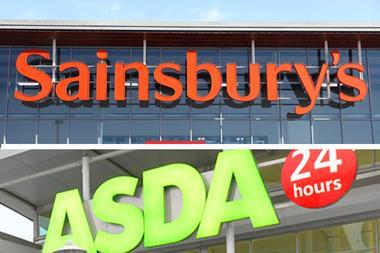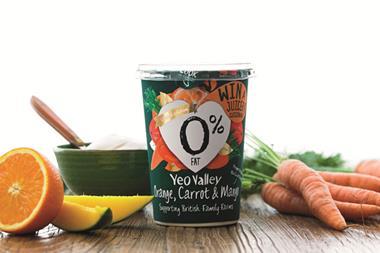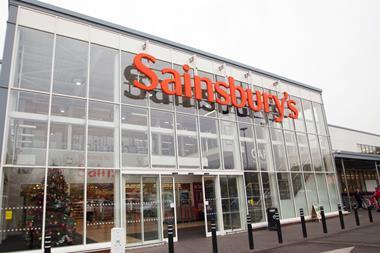Sainsbury’s and Asda have launched the case for the defence of their merger plans, coming hot on the heels of last week’s claims by retailer and supplier groups that the deal will give the companies an iron grip on the market and destroy competition.
In a 75-page document, released by the Competition & Markets Authority (CMA) yesterday (13 November) in response to its issues statement last month, the supermarket giants listed the many reasons why the watchdog should give the deal the green light.
1. Aldi and Lidl are ‘compelling threat’
Last week The Grocer revealed how Aldi had urged the CMA to throw out the merger, claiming the rise of the discounters had been used to mask the threat of a duopoly that would destroy competition in UK grocery.
The discounter claimed it and Lidl are in fact not in the same league as the big four and should not be used in the deciding equation.
That claim is rubbished by Sainsbury’s and Asda who described the rise of the discounters as a “compelling threat” to the entire grocery retail market.
‘Aldi and Lidl are mainstream competitors who have disrupted the UK market and continue to do so,’ said the would-be merger partners. ’Their reinvented retail offer combines convenient locations, high quality (including fresh and premium) products, with the lowest prices in the industry.
‘Their product range serves customers’ “main shop” needs and has increased their mainstream appeal across all demographic groups.
‘The investment they have made to reposition their customer offer has driven a significant increase in sales intensity per square metre: Aldi is nearly three times more productive per square metre than it was in 2010; Lidl is nearly twice as productive.’
Sainsbury’s and Asda also pointed to the aggressive store expansion programme of both Aldi and Lidl.
‘The result is that over the past five years, both parties (and the traditional retailers as a whole) have lost significant market share equating to billions of pounds of lost sales to Aldi and Lidl’s existing stores, and their newly opened ones, across all local markets.’
Read more: Aldi urges CMA to put a stop to Sainsbury’s-Asda merger
2. The merger is the only way for Sainsbury’s and Asda to lower prices
Ever since the merger was announced Sainsbury’s and Asda have made great play of how an estimated £500m synergies would be ploughed into price cuts to consumers. But the new document said if the merger is blocked neither supermarket would be able to compete on prices given the changes in the market brought about by the rise of the discounters.
They said there is ‘stronger-than-ever consumer expectation’ of increased quality and convenience but at lower prices.
’Making sufficient investment in their propositions to fully address these challenges requires them to narrow the cost advantage of many competitors, including Aldi, Lidl, Tesco and bargain stores. This cost reduction requires a significant change to their underlying operating models - a change that the parties would be unable to sustainably achieve without the proposed merger.
’In order to reduce prices to customers, the parties need to reduce their purchasing cost of goods sold. The vast majority of these are purchasing cost savings synergies through harmonisation of buying terms.
’This would significantly narrow the purchasing cost gap to the discounters and Tesco, each of whom enjoy a much larger volume per product purchased.
‘These savings are not achievable without the proposed merger.’
3. The threat to suppliers is exaggerated
The CMA said last month it would investigate whether the merger could reduce innovation on the part of suppliers and lead to a so-called “waterbed effect” which would see suppliers slash prices under pressure from the merged titan and put them up elsewhere.
Sainsbury’s and Asda said they do not have a high enough share over procurement in any of the major grocery categories to justify such fears.
‘With respect to innovation, the vast majority of the expected efficiencies are driven by gains made from large multinational suppliers, active across countries and in channels other than grocery retail,’ they added.
‘These suppliers can easily spread the costs of innovation, given the volume of sales that accompany their international dimensions - their innovation incentives are in no way dependent on sales to the parties.’
In a bid to trash the “waterbed” theory, Sainsbury’s and Asda also claimed it is completely unrealistic that ‘weak’ retailers in the market could suddenly be forced to accept higher prices by suppliers looking to regain lost profit margins.
‘Suppliers should be expected to be already profit maximising in relation to their existing third party customers,’ it said. ‘As the CMA recognised in Tesco-Booker: “if a supplier could profitably charge “weak buyers” higher prices, one would expect it already to be doing so.”’
The merger partners also claimed Groceries Code Adjudicator Christine Tacon would protect suppliers from the threat of misused buying power, despite her inability to intervene on matters of price.
‘GSCOP contains detailed rules regarding conduct in relation to all direct suppliers, both large and small, in order to remove excessive risks or unexpected costs being passed on to the suppliers,’ it said.
‘There is no reason to believe that the GCA could not continue to effectively protect the interests of suppliers in their dealings with the parties post-merger. It is clear that the GCA herself considers that this is the case. She has stated that “the size of the retailers makes no difference to my ability to regulate them”.’
Opinion: Sleeping with the enemy will become retail’s ‘new normal’
4. The looming challenge from Amazon and other new players
As well as Aldi and Lidl, Sainsbury’s and Asda single out the rise of Amazon as a ‘critical factor’ in why the merger should be allowed to go ahead.
‘Amazon has not only expanded online but is now signalling a large-scale expansion in in-store grocery,’ said their response, which highlighted speculation suggesting Amazon is planning a massive expansion of its Amazon Go convenience store offering and a UK expansion of its Whole Foods offering backed by its technological might.
‘Amazon is expanding online via its Amazon Fresh offer, and has now signalled large-scale expansion in relation to in-store grocery (via Amazon Go) and is believed to be considering a greater physical UK retail presence, having already acquired a footprint of Whole Foods stores in the UK alongside its distribution warehouse presence,’ it continued.
It also urges the CMA to consider the rapid expansion of other competitors, such as Iceland, Home Bargains and B&M.
5. Large stores’ advantages over medium stores ‘obsolete’
In its issues statement the CMA suggested the large stores operated by Sainsbury’s and Asda had advantages over the sort of medium-sized stores run by Aldi and Lidl, including a wider range, concessions, more GM and amenities such as cafés.
But Sainsbury’s and Asda claimed with the switch away from one-stop shopping to top-up shops, the likes of Aldi and Lidl are increasingly becoming the destination for customers’ main shop.
‘The fact that medium stores are a credible alternative to large stores is very simply evidenced by millions of customers actually doing their main shop in medium stores,’ they said, citing Nielsen figures which suggested 62% of grocery shoppers say they now shop more than once a week .
‘The range of shopping missions served by medium stores is aptly demonstrated by the disruptive influence of Aldi and Lidl on competition for main shops, top-up shops and food for later. Among the most telling statistics as to the relative customer usage of medium stores (in particular those of Aldi and Lidl) for main shops are that the proportion of spend through Aldi and Lidl characterised as main shop (49.7% in 2018) exceeds that for traditional retailers (41.8% in 2018).’
6. Fear of ‘big three’ co-ordination on prices ‘unrealistic’
Much of the opposition to the merger from retailers so far has focused on the potential for the creation of an all-powerful ‘duopoly’ with a hold over 60% of the market.
But Sainsbury’s and Asda claimed ‘co-ordination’ between the post-merger ‘big three’ would be unsustainable even if the players involved wanted to bring it about, which, they insisted, they don’t.
They pointed to the competition from the Co-op, Waitrose, M&S and, increasingly, from B&M and Home Bargains.
‘Data from Nielsen shows that these operators have a steadily increasing share of sales, a trend that would only be accelerated if prices on goods were to rise at the post-merger big three.’
Meanwhile the prospect of Asda and Sainsbury’s colluding with Tesco on prices was pie in the sky, it said.
‘Given that the proposed merger will allow the parties to achieve substantial purchasing synergies, it is likely to increase rivalry between the parties and Tesco rather than reduce it. Thus, Tesco’s incentives to co-ordinate will not increase post-merger.’
In depth: Sainsbury’s-Asda merger clearance ‘tough’ warns ex-CMA director
7. Sainsbury’s and Asda not big enough to dictate fuel and GM prices
With the CMA set to probe the potential for a damaging reduction in competition in fuel prices, Sainsbury’s and Asda claimed they are not big enough players in the market to throw their weight around.
The submission said the two parties volume ranks below major oil giants such as BP, Shell and Esso, as well as Tesco, with Asda also behind Morrisons in the pecking order.
‘Competition between fuel retailers is intense, reflected in relatively low industry margins, a low degree of mark-up over cost by fuel retailers, whereby the vast majority of the price paid at the pump is fuel duty, tax and the crude price of oil,’ they said.
When it comes to general merchandise - another area the CMA has said it will probe, particularly in relation to toys, electricals and clothing - Asda and Sainsbury’s also claim they are not big enough to merit concern.
’Across these categories the parties have low combined shares of supply, their offerings are not particularly close, relative to rivals, and the parties face strong competition from a range of competitors.
’For retailing of toys, competitors include Amazon, Smiths, The Entertainer, Tesco, B&M, Aldi, Lidl and Morrisons. For retailing of electricals, competitors include Amazon, Dixons, John Lewis, Dunelm, Boots, B&M, Aldi, The Range and Home Bargains.
‘With respect to the retail sale of clothing, competitors include Primark, Next, M&S, Matalan, New Look, Very, Asos, Tesco and many others.’
8. The online groceries market shouldn’t be considered in isolation
The CMA said last month its inquiry would include scrutiny of the potential for online competition being hit.
In their submissions both Morrisons and Waitrose urged the CMA to consider blocking the merger based on the huge online groceries share that would be held by the companies, alongside Tesco.
But in its submission Sainsbury’s and Asda said the nature of the grocery market meant it was unrealistic this would lead to less competition.
’Put simply, customers shopping online expect the same prices and products as in-store, and are highly sensitive to the separate charge for home delivery.
‘They would switch to physical stores if the online delivery proposition worsened and the delivery charge were no longer the same value for money in convenience terms.’
They also said the merger if it went ahead would continue to face ‘strong constraints’ from other grocery retailers operating online, ‘in particular Tesco, Ocado and Morrisons’.



















1 Readers' comment